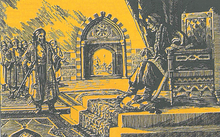Fakhr al-Din I
| Fakhr-al-Din I | |
|---|---|
| Emir of the Chouf | |
| Successor | Yunis ibn Fakhr al-Din |
| Died | 1506 |
| Issue | Yunis |
| House | Ma'n |
| Father | Al-Hajj Yunis Ma'n |
| Religion | Druze |
Fakhr al-Din Uthman ibn al-Hajj Yunis Ibn Ma'n (
Before modern research by Kamal Salibi, most modern historians, including Salibi initially, based their information about Fakhr al-Din on the 19th-century works of local historian Haydar al-Shihabi, who confused him with his grandson, Qurqumaz ibn Yunis, and placed his death in 1544.
Family origins
The
Sources and identification

Modern sources largely derive information about the Ma'nid period in Mount Lebanon preceding the rule of
Biography

According to Salibi, Fakhr al-Din was the first Ma'nid "whose historicity is beyond question".
According to the historian William Harris, in the 1490s Fakhr al-Din entered into an alliance with the Bani al-Hansh, a
Succession

Fakhr al-Din was succeeded by his son Yunis, who according to Ibn Sibat died "a young man of reverence, power, and dignity" in 1511-12.
The chronicle of Duwayhi indicates that Qurqumaz succeeded Yunis and continued to hold the emirate of the Chouf in 1528, though it contains no information about the Chouf emirate between then and 1586, when Shihabi and Shidyaq hold Qurqumaz died (Duwayhi places his death in 1584).[12] In the assessment of Salibi, Shihabi likely erred in the reconstruction of the Ma'nid family due to the exceptionally long reign of Qurqumaz (1511–1586).[13] Salibi surmises that Qurqumaz succeeded his father while a young child and must have been assisted in ruling the emirate by his close Ma'nid kinsman Alam al-Din Sulayman (likely an uncle or cousin), who was mentioned by Ibn Sibat as having been imprisoned relatively briefly with Qurqumaz by Janbirdi al-Ghazali, the Ottoman governor of Damascus, in 1518.[14]
References
- ^ a b c Harris 2012, pp. 59, 78.
- ^ a b Salibi 1973, p. 273
- ^ Salibi 1973, p. 273–274.
- ^ Salibi 1973, p. 274.
- ^ Salibi, 1973, p. 276.
- ^ Bosworth 2006, p. 68, note 123.
- ^ Salibi 1991, p. 343.
- ^ a b c d Salibi, 1973, p. 277.
- ^ Salibi 2005, p. 123.
- ^ a b Harris 2012, p. 78.
- ^ Hourani 2010, p. 918.
- ^ a b c d Salibi, 1973, p. 278.
- ^ Salibi 1973, p. 280.
- ^ Salibi 1973, pp. 280–281.
Bibliography
- ISBN 0-7546-5708-6.
- Harris, William (2012). Lebanon: A History, 600 - 2011. New York: Oxford University Press. ISBN 978-0-19-518-111-1.
- Hourani, Alexander (2010). New Documents on the History of Mount Lebanon and Arabistan in the 10th and 11th Centuries H. Beirut.
{{cite book}}: CS1 maint: location missing publisher (link) - OCLC 495469475.
- Salibi, K. (1991). "Maʿn". In ISBN 978-90-04-08112-3.
- Salibi, Kamal S. (July 1973). "The Secret of the House of Ma'n". International Journal of Middle East Studies. 4 (3): 272–287. S2CID 163020137.
- Salibi, Kamal S. (2005). A House of Many Mansions: The History of Lebanon Reconsidered. I.B. Tauris. ISBN 978-1-86064-912-7.
- Sluglett, Peter (2010). "Introduction". In Sluglett, Peter; Weber, Stefan (eds.). Syria and Bilad Al-Sham Under Ottoman Rule: Essays in Honour of Abdul Karim Rafeq. Leiden: Brill. ISBN 978-90-04-18193-9.
